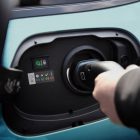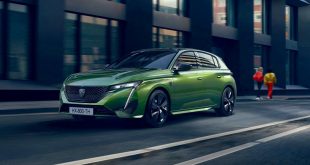The new-generation Peugeot 308 SW wagon has bowed in as a practical and sexy alternative to compact SUVs.
Likely to be badged 308 Touring when it arrives in Australia in 2022, the wagon sits on a 55mm longer (to 2732mm) wheelbase and has a 210mm longer rear overhang compared to the 308 hatch.
The result is a larger boot space: 608 litres versus 412 for the hatch. It expands to 1634 litres (up 311 litres) when the 40:20:40 rear seats are folded, enabling it to swallow objects longer than 1.85m.
Compared to the outgoing 308 wagon, the 2022 model is 60mm longer at 4640mm, 20mm lower at 1440mm, with the windscreen mounted further back into the body for a sportier look.
While the SW shares its front fascia with the 308 hatch, the redesigned tail features freestanding LED taillights as opposed to the connected design of the hatch along with an integrated spoiler and a raked rear windscreen. For practicality, the boot also reaches lower to the rear bumper for easy loading and unloading.
Inside, the futuristic i-Cockpit dashboard is carried over from the hatch combining a 10-inch 3D digital instrument cluster with a 10-inch infotainment screen with Apple CarPlay, Android Auto, satellite navigation and multi-connection Bluetooth. Peugeot’s signature small-diameter steering wheel also makes a return.
Other interior highlights include the new ‘OK Peugeot’ voice assistant, 10-speaker Focal premium sound system, wireless smartphone charging, two USB-C ports, eight colour ambient lighting and a compact gear shift level on automatic models.
The 308 also benefits from the latest driving assistance systems including autonomous emergency braking with pedestrian and cyclist detection, driver attention monitoring, auto high-beam, adaptive cruise control, lane-keep assist, long-range blind-spot monitoring, rear cross-traffic alert and a 360 degree camera.
The 308 SW is available with a range of petrol, diesel and plug-in hybrid powertrains, although it isn’t clear which options will be offered in Australia just yet.
On the petrol front, there is a 1.2-litre turbo three-cylinder in two states of tune – 81kW and 96kW, both paired with a six-speed manual as standard, with the latter available with an eight-speed automatic.
There is also a 96kW 1.5-litre four-cylinder turbo-diesel connected to either a six-speed manual or eight-speed automatic transmission.
Finally, two plug-in hybrid options are available in Europe, both employing a 1.6-litre turbo-petrol four-cylinder married with an 81kW electric motor and eight-speed automatic transmission.
Both draw electron from a 12.4kWh battery that can be recharged in just over seven hours on a single-phase AC socket, or one hour and 55 minutes with a 7.4kW home wallbox.
Entry-level PHEVs will produce a combined 132kW along with a 60km all-electric range based on Europe’s WLTP testing procedures, while flagship variants churns out a combined 165kW and 59km of electric range.
 ForceGT.com Car News, Car Reviews, Video Reviews, Tuning and much more.
ForceGT.com Car News, Car Reviews, Video Reviews, Tuning and much more. 

















